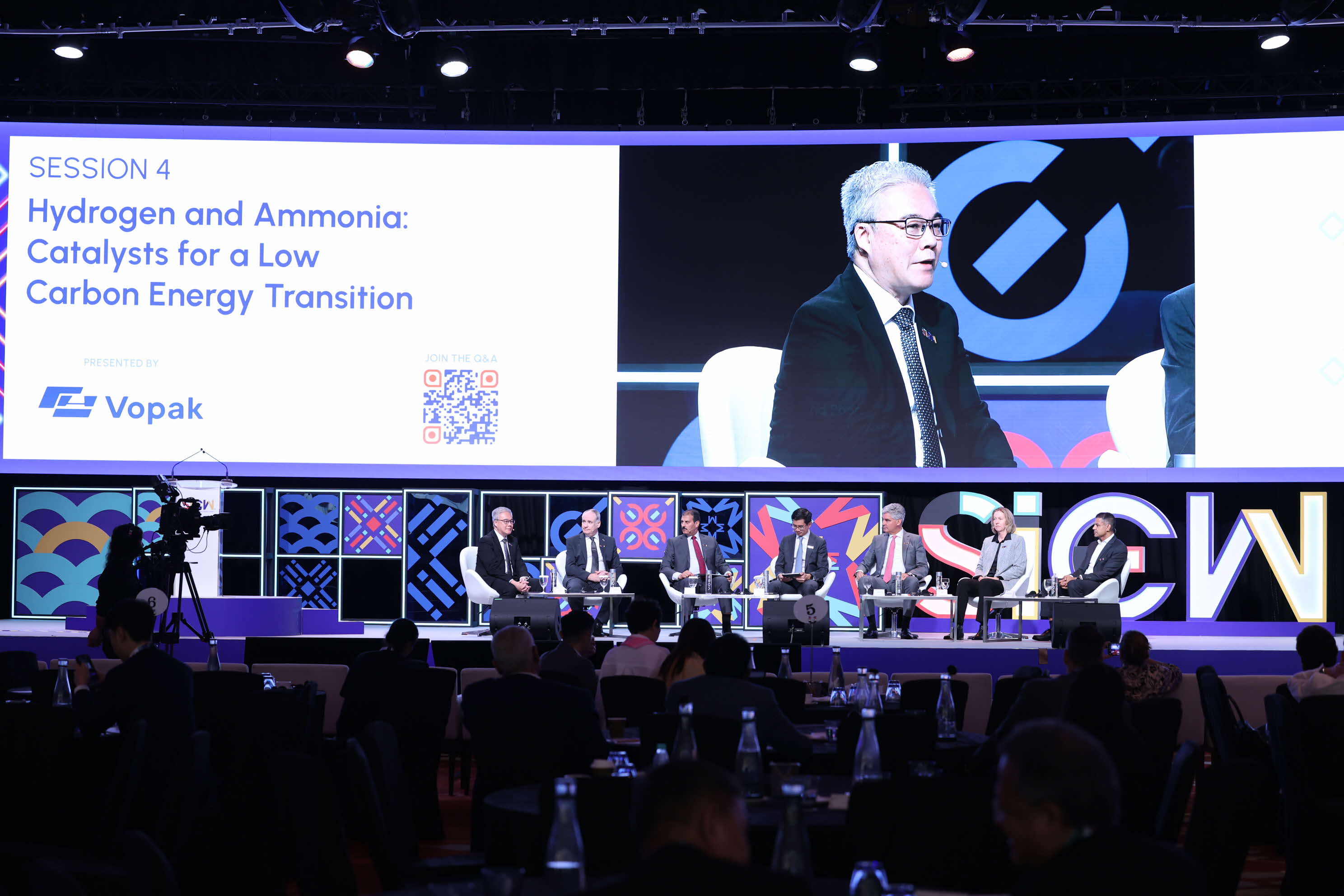Session 4 of the SIEW Summit focused on "Hydrogen and Ammonia: Catalysts for a Low Carbon Energy". The topic brought together governments and private-sector representatives to discuss the role of hydrogen and ammonia as catalysts for the low carbon energy transition.

Moderated by Albert Cheung, Deputy Chief Executive Officer, BloombergNEF, the discussion explored the challenges and opportunities for hydrogen and ammonia in the global energy landscape.
Slow progress in clean hydrogen investment
Despite growing interest in hydrogen and ammonia, the progress in clean hydrogen investment has been slow due to high costs and lagging demand.
Dick Richelle, Chairman of the Executive Board and Group Chief Executive Officer, Royal Vopak, explained that 400 million tonnes of clean hydrogen is needed by 2050 to meet net zero targets. However, adoption remains slow. Mr Richelle emphasised the need for infrastructure investment to accelerate the energy transition. He pointed to Royal Vopak's experience in handling ammonia at six locations globally as an example of the company's commitment to supporting this growth.
Government strategies and the importance of international collaboration
Government representatives outlined their hydrogen strategies and stressed the importance of collaboration. H.E. Richard Lochhead, Minister for Business, Scottish Government, highlighted Scotland’s potential in hydrogen, noting partnerships with countries like Germany and Singapore for future hydrogen exports.
H.E. Dr Ahmed Mohina, First Undersecretary of Strategic Planning, Ministry of Electricity and Renewable Energy, Egypt, outlined his country's strategy to capture 5-8 percent of the global green hydrogen market. He highlighted that Egypt’s ideal geographic position—at the crossroads of Africa, Asia, and Europe—makes it well positioned to serve as a major hub for green hydrogen exports.
Raymond Poon, Director, Electrical and Mechanical Services Department, Hong Kong SAR, China, highlighted Hong Kong’s pilot projects in hydrogen across sectors like land transport, construction sites, and electricity generation. He acknowledged, though, that there were challenges related to safety, technology, infrastructure, and public acceptance.
The role of policies and level playing fields
Panelists agreed on the need for supportive policies and a level playing field for low-carbon products like hydrogen and ammonia. Meg O’Neill, Chief Executive Officer and Managing Director, Woodside Energy, highlighted the importance of partnerships with infrastructure companies like Royal Vopak. She also pointed out that "the costs of lower carbon products are higher than the costs of today's energy systems".
She stressed the need for policy settings like US's Inflation Reduction Act to provide financial support for carbon capture and sequestration.
Mr Richelle added that aligning technology, infrastructure, production, and demand is essential for establishing robust supply chains.
The need for ecosystem solutions and partnerships
Ravi Balasubramanian, Managing Director, Portfolio Development Group, Managing Director, Investment Group, New Energy and Industrials, Temasek, discussed the importance of partnerships in scaling low carbon projects. He cited Temasek's investment in H2 Green Steel as an example of how startups can attract customers and financiers despite challenging market conditions.
Mr Balasubramanian also emphasised the role of financing partnerships in solving ecosystem challenges. He gave the example of Temasek's collaboration with Blackrock and Pentagreen, which focus on advancing low carbon projects that are marginally bankable, or projects that don’t usually get a last order of financing.
Potential for hydrogen and ammonia as export commodities
The panelists agreed that hydrogen and ammonia have strong potential as future export commodities but noted current market limitations. Ms O'Neil pointed out that ammonia is already being shipped globally and that a Memorandum of Understanding has been signed to supply liquid hydrogen from Australia to Singapore.
However, she expressed skepticism about achieving a fully liquid market, emphasizing the need for collective decision-making. She added that commercial certainty is essential to align all key players—the producer, the customer, and the infrastructure that connects them.
H.E. Dr Mohina echoed this sentiment, stating that while the world has been talking about green hydrogen for the past three to four years, major projects have yet to materialise.
Minister Lochhead added that Scotland has significant carbon capture projects in the pipeline, including those involving hydrogen. However, he acknowledged that the development of a fully liquid market depends on market realities.
The session provided valuable insights from both private- and public-sector experts on the challenges and opportunities of hydrogen and ammonia adoption. The discussion highlighted the need for supportive policy, infrastructure development, and international collaboration to accelerate the energy transition.
Stay tuned as the conversation evolves throughout the day. Follow @SIEW_sg on Telegram and Twitter for key insights, as we navigate Day 1 together.